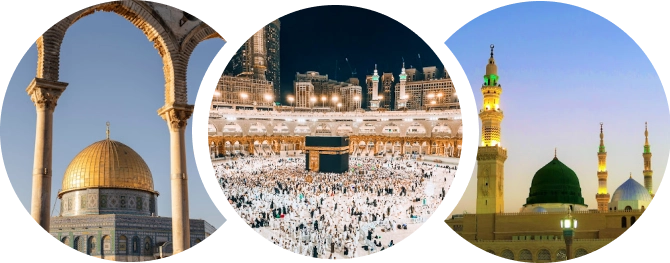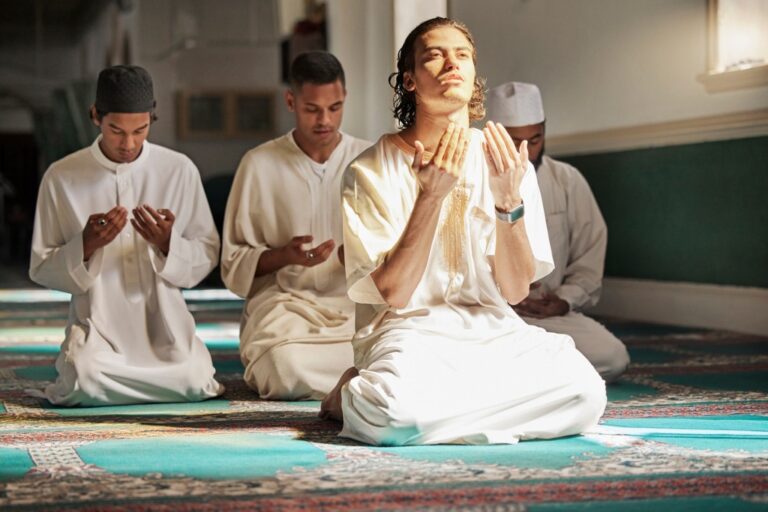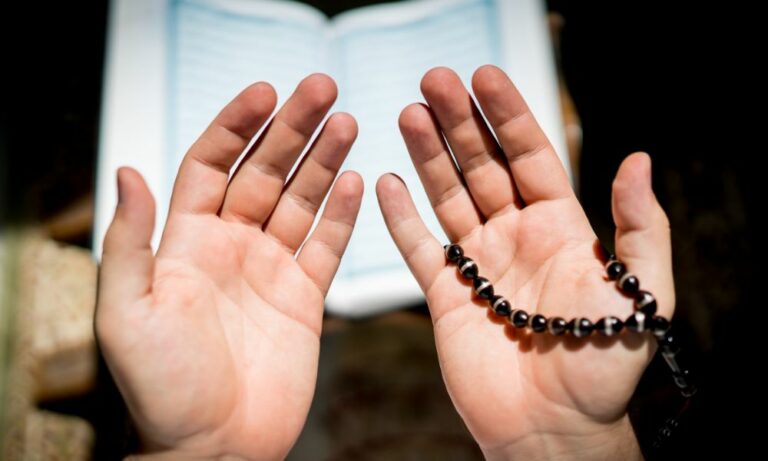How to Perform Dhuhr Prayer: Master Praying Dhuhr in Simple Steps!
Are you new to Islam or simply need a refresher on how to perform the Dhuhr prayer correctly? Dhuhr is a midday prayer, one of Islam’s five pillars and an essential act of submission and devotion.
We’ll walk you through everything in this comprehensive guide, from when to pray, the number of Rak’ahs involved, and its vital role in our spiritual journey.
Stay with us, and you’ll find strength and solace in this sacred act by the end, deepening your connection with Allah SWT every day at noon.
Understanding Dhuhr Prayer


Dhuhr prayer is performed at noon and consists of a specific number of Rakats.
What is Dhuhr Prayer?
Dhuhr prayer, also known as the noon prayer, holds a significant place in the daily rituals of practicing Muslims. It’s the fourth Islamic prayer of the day, typically performed when the sun descends towards the west from its zenith in the sky.
When to perform Dhuhr Prayer?
Marking the sun’s zenith is the commencement of Dhuhr prayer, standing as a significant part of every Muslim’s day. This noon prayer comes after Fajr (pre-dawn prayer) and precedes Asr (afternoon), Maghrib (evening), and Isha (night).
An ideal time for this daily Muslim obligation fluctuates between 12 PM and 1:30 PM, depending on each day and geographical location. The sun must descend towards the west from its peak before initiating these prayers, respecting their sacred nature and timing.
During summer months or extreme heat, consider delaying your Dhuhr Prayer to mitigate any discomfort you might face during your devotion. As Prophet Muhammad has also commanded in one of his hadith:
“ . قَالَ ابْنُ مَوْهَبٍ ” بِالصَّلاَةِ فَإِنَّ شِدَّةَ الْحَرِّ مِنْ فَيْحِ جَهَنَّمَ ” .
When the heat is violent, offer (the Zuhr) prayer when it becomes reasonably cool, for the violent heat comes from the bubbling over the Hell.
Asr starts at the end of Dhuhr, so Dhuhr ends when Asr starts. This makes a good time for worship.
Remember that different Islamic schools may have different ideas about certain times. Still, most of them agree on this shared framework.
How many Rak’ah are there in Dhuhr Prayer?
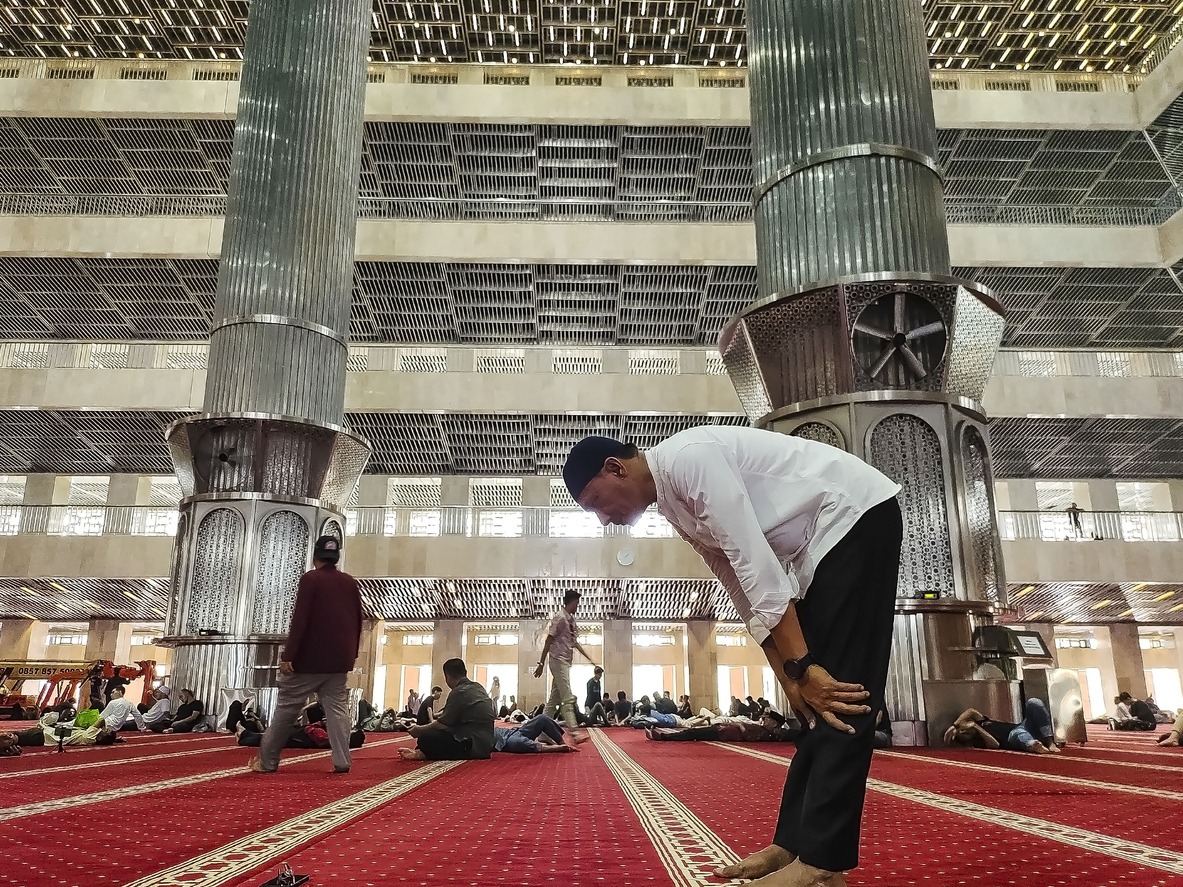

The Dhuhr prayer comprises 12 Rakats or units of prayers in the following form:
- Four Sunnah (Recommended)
- Four Fard (Obligartory)
- Two Sunnah (Recommended)
- Two Nafl (Optional)
With its many steps, this midday ritual is meant to strengthen your spiritual connection and ask Allah SWT for his blessings and mercy.
How to Perform Dhuhr Prayer?
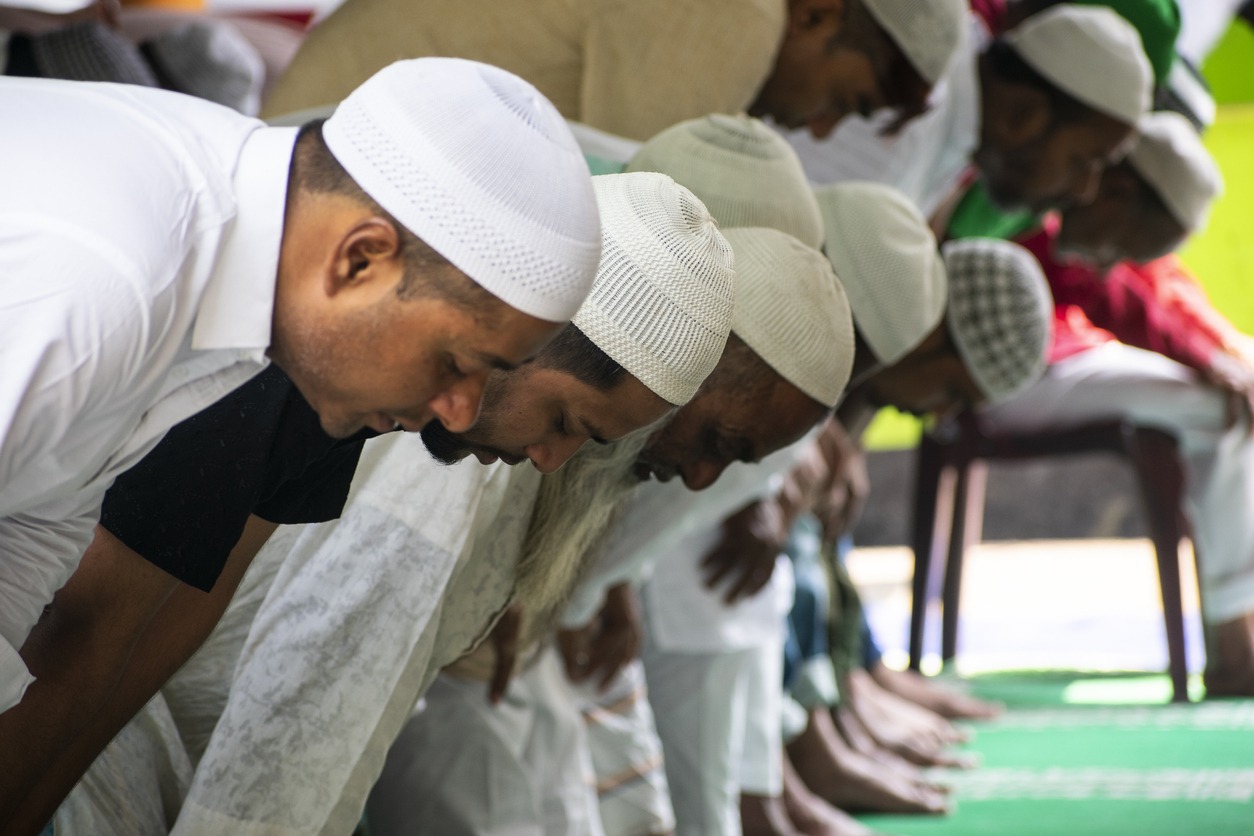

To perform the Dhuhr prayer, start by preparing for the prayer with ablution, finding a quiet place, and having the intention to perform it. Then, offer 4 Rakats of Sunnah prayers followed by 4 Rakats of Fard prayers.
Finally, conclude with 2 Rakats of Sunnah prayers, or you may perform 2 Nafl if you wish to do so.
Performing 4 Rakats Of Sunnah (or Fard):
To perform the 4 Rakats Sunnah as part of the Dhuhr prayer, follow these steps:
- Start by performing the ablution (wudhu) to purify yourself for prayer. Sunan Abi Dawud 171
- Find a clean and quiet place so you can concentrate and focus on your prayer.
- Begin with the intention (niyyah) of performing the 4 Rakats Sunnah (or Fard) of Dhuhr prayer to seek closeness to Allah SWT and earn rewards.
- Stand facing the direction of the Kaaba (Qiblah).
- Raise your hands up to your ears and say “Allahu Akbar” to start the prayer. (Book 2, Hadith 155)
- Place your right hand over your left hand on your chest, just below your navel. Sunan Abi Dawud 759
- Start with Dua of Istiftah .سُبْحَانَكَ اللّٰهُمَّ وَبِحَمْدِكَ ، وَتَبَارَكَ اسْمُكَ ، وَتَعَالَىٰ جَدُّكَ ، وَلَا إِلٰهَ غَيْرُكَ (it is only recited in the first Rakah) Sunan an-Nasa’i 900
- Seek Refuge of Allah from Satan, and begin in Allah’s name, then Recite Surah Al-Fatiha, the first chapter of the Quran, quietly or silently. (Book 2, Hadith 172)
- Follow it with a short passage or verse from any other chapter (Surah) of the Quran, known as a surah or verse recitation. Sahih Muslim 396c
- Perform a bowing position (ruku) by bending from your waist while keeping your back straight and hands resting on your knees and say “Subhana Rabbi Yal Adheem” and say it at least three times. Riyad as-Salihin 1175
- Rise from the bowing position and stand upright while saying “Sami Allaahu Liman” Hamidah” in an audible voice, which means “Allah SWT hears those who praise Him.” Sunan an-Nasa’i 1072
- Continue by saying “Rabbanaa wa lak al-hamd” silently, meaning “Our Lord, all praise is due to You.” Sunan Ibn Majah 877
- Prostrate (sajdah) by placing your forehead, nose, palms, knees, and toes on the ground while saying “Subhaana Rabb-Bi Yal Aa’la”, which means “Glory be to my Lord Almighty.” Sunan an-Nasa’i 1046
- Sit up briefly in a sitting position called jalsa and recite “Rabbighfirli” (Oh Lord, forgive me) before returning to prostration for a second time. Sunan Ibn Majah 897
- After the second prostration, stand up and follow the same steps from 8-14 for the second Rakah.
- After completing the second Sajdah in the second Rakat, sit up straight for Tashahud. Recite “At-tahiyyatu lillahi was-salawatu wat-tayyibat. As-salamu ‘alaika ayyuhan-nabiyyu wa rahmatullahi wa barakatuh” (All compliments, prayers, and pure words are due to Allah SWT. Peace be upon you, O Prophet, and the mercy of Allah SWT and His blessings). Sahih al-Bukhari 831
- Repeat steps 8 to 15 again to complete the third and fourth Rakah.
- After completing the 4th Rakat, remain seated in a sitting position and recite the Tashahud. Then recite Durood-e-Ibrahimi, and after that, recite the dua “Allahumma Rabbana atina fid dunya hasanah wa fil akhirati hasanah wa qina ‘adhaban nar” Sahih al-Bukhari 3370, Sahih al-Bukhari 4522
- Finish the prayer by turning your face to the right and saying “Assalamu Alaikum wa Rahmatullah,” meaning “Peace be upon you and Allah SWT’s “
Performing 2 Rakah of Sunnah:
The two sunnah are also performed in the same manner as described above. You only need to set your intention for praying 2 Rakah of sunnah.
But Instead of standing up after reciting tashahhud in the second Rakah, you follow it with Durood-e-Ibrahimi, and the famous dua: “Allahumma Rabbana atina fid dunya hasanah wa fil akhirati hasanah wa qina ‘adhaban nar”
Special Considerations for Dhuhr Prayer
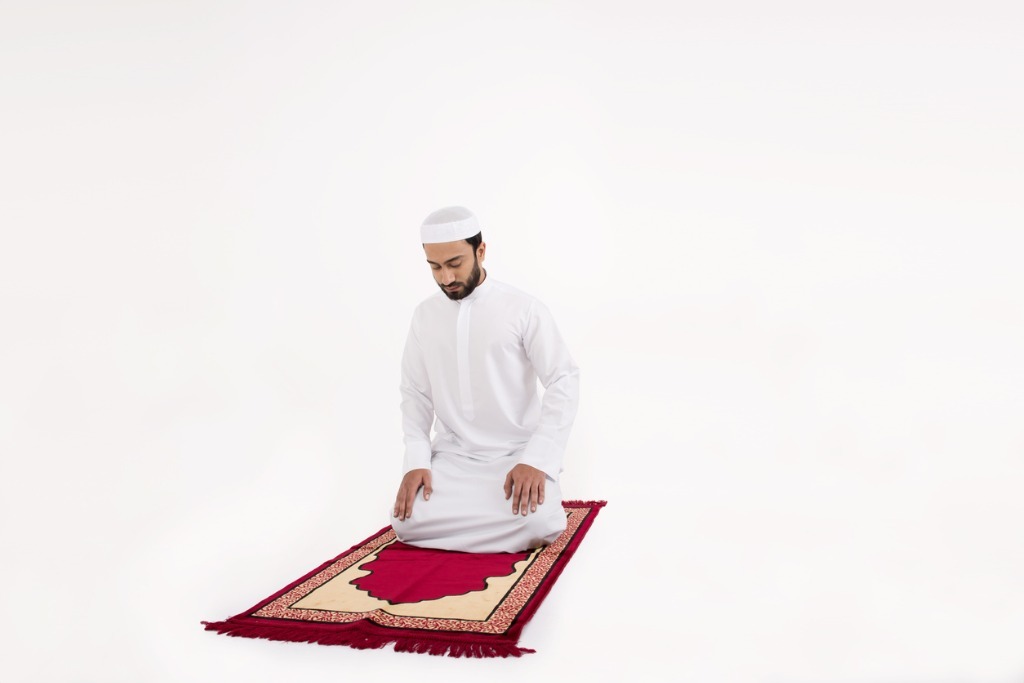

Learn the special considerations for Dhuhr Prayer on Fridays and why Dhuhr and Asr prayers are recited silently. Discover the significance behind these practices and enhance your prayer experience.
How to pray Dhuhr on Friday?
Praying Dhuhr on Friday is slightly different from the regular Dhuhr prayer. Here’s how you can perform it:
- Offer the regular 4 rakats Sunnah prayer before the Friday sermon.
- Listen attentively to the Khutbah or sermon.
- After the Khutbah, stand up and pray the 2 Rakats Fard prayer of Jumuah in congregation.
- Remember to recite Surah Al–Fatiha silently behind the Imam. There is no need to recite any other Quranic verses.
- Perform the prayer as you would for regular Dhuhr prayer, including bowing (Ruku), prostration (Sujood), and sitting between the two prostrations (Jalsa).
- Offering Friday prayer (Jummah) is obligatory for adult male Muslims.
- The Friday prayer consists of a sermon (Khutbah) delivered by an Imam before the congregational prayer.
- The regular Dhuhr prayer is incorporated into Friday prayer.
- It is recommended to perform extra acts of worship before attending Friday prayer, such as reading Surah Kahf, offering voluntary prayers, Duas and saying, “Allahuma salli wa sallem was barek ala sayyedina Muhammed.”
Why are Dhuhr and Asr recited silently?
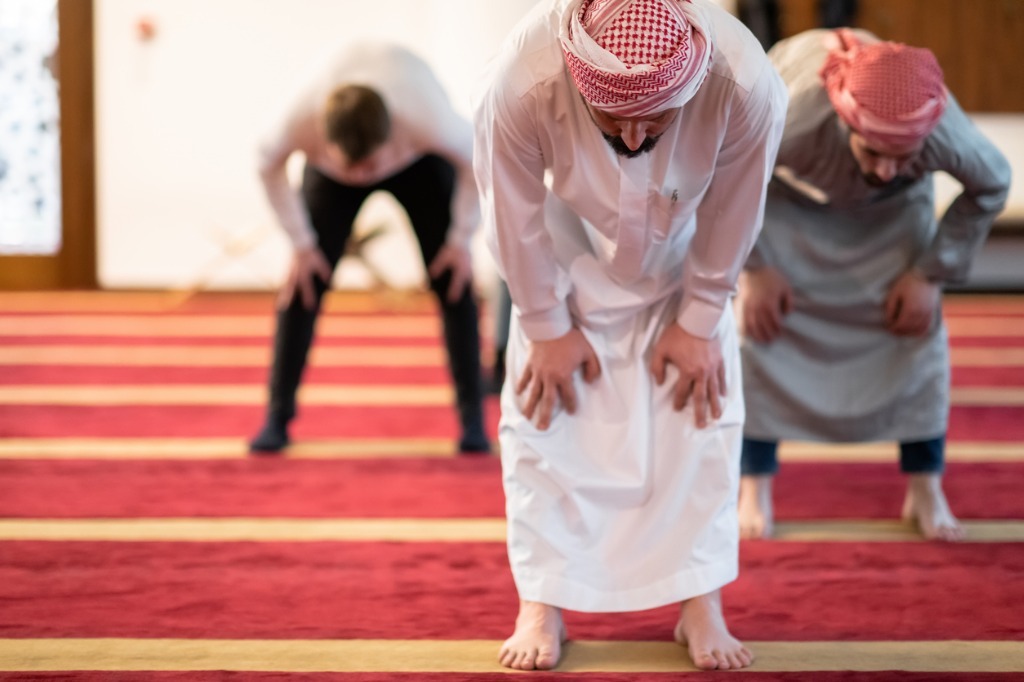

In Islam, the Dhuhr and Asr prayers are said silently to help people pay attention and be sincere. This makes it possible for people to connect with Allah SWT without any interruptions or other things getting in the way.
By saying these prayers in silence, believers can keep their minds calm and peaceful, which helps them focus on their worship. Also, saying these prayers in silence shows that our relationship with Allah SWT is personal and close.
So, when you pray the Dhuhr and Asr prayers, ensure your heart is filled with quiet devotion as you try to get closer to God.
Hadiths about Dhuhr Prayer
There are several hadiths that emphasize the importance and rewards of offering Dhuhr prayer.
According to Prophet Muhammad (peace be upon him), whoever prays four Rakats before Zuhr prayer and two Rakats after Zuhr prayer, Allah SWT will build a house for them in paradise
اثْنَتَا عَشْرَةَ رَكْعَةً مَنْ صَلاَّهُنَّ بَنَى اللَّهُ لَهُ بَيْتًا فِي الْجَنَّةِ أَرْبَعَ رَكَعَاتٍ قَبْلَ الظُّهْرِ وَرَكْعَتَيْنِ بَعْدَ الظُّهْرِ وَرَكْعَتَيْنِ قَبْلَ الْعَصْرِ وَرَكْعَتَيْنِ بَعْدَ الْمَغْرِبِ وَرَكْعَتَيْنِ قَبْلَ صَلاَةِ الصُّبْحِ ”
“Twelve rak’ahs, whoever prays them Allah SWT will build for him a house in Paradise: four rak’ahs before Zuhr and two rak’ahs after Zuhr, two rak’ahs before Asr, two rak’ahs after Maghrib and two rak’ahs before Subh prayer.”
Prophet Muhammad PBUH also said about the Duhr prayer:
وَلَوْ يَعْلَمُونَ مَا فِي التَّهْجِيرِ لاَسْتَبَقُوا إِلَيْهِ
“… and if they knew the reward of the Zuhr prayer (in the early moments of its stated time), they would race for it (go early)…”
This shows how important these extra prayers are if you want more rewards from Allah SWT. Also, regularly praying the Dhuhr prayer can keep a person from going to Hell on the Day of Judgment and bring blessings and mercy from Almighty Allah SWT.
These hadiths remind us of how important and spiritually beneficial it is to pray the Dhuhr prayer with sincerity and devotion.
Common Questions About Dhuhr Prayer
Being a central aspect of a Muslim’s daily routine, Dhuhr prayer often raises various questions. Here are some of the commonly asked ones, along with their detailed responses for your understanding:
| Common Questions | Answers |
|---|---|
| Can I delay the Dhuhr prayer if it’s very hot? | Yes, it is permissible to delay the Dhuhr prayer if the weather is extremely hot. It is based on the Sunnah of the Prophet. Sahih al-Bukhari 3259 |
| How many Rak’ahs are in Dhuhr prayer? | Dhuhr prayer consists of four Rak’ahs of Sunnat, four Rak’ahs of Fard, two Rak’ahs of Sunnat, and two Rak’ahs of Nafl. |
| Why are the hands folded over the chest during the prayer? | The hands are folded over the chest, right over left, in the standing position to emulate the example set by the Prophet. Sunan Abi Dawud 759 |
| What is the importance of the Ruku’ in prayer? | The Ruku’ is a crucial part of prayer, symbolizing humility and submission to Allah SWT. It is performed by grasping the knees firmly with hands and keeping the back straight. |
Conclusion
Dhuhr prayer is an integral part of the Islamic religion. You can build a strong connection with Allah SWT by following this step-by-step guide and understanding what it means.
Remember to pray the Sunnah and Fard prayers and to pay attention to the special rules for the Dhuhr prayer on Fridays. This midday prayer has many benefits for your body, mind, and spirit.
So, take a minute to get ready and start this beautiful journey of devotion and peace.
FAQs
What are the steps to perform Dhuhr Prayer?
Making the intention, standing and facing the qibla, raising hands and saying Allahu Akbar (Takbeer), reciting Surah Al-Fatihah and another portion of the Quran, performing ruku (bowing), rising from ruku into a standing position again, performing sujood (prostration) twice, sitting between prostrations, and concluding the prayer with greetings are all steps in performing Dhuhr Prayer.
When is the best time to perform Dhuhr Prayer?
Dhuhr Prayer is best performed after the sun has passed its zenith and before Asr Prayer. It is suggested that you pray as soon as possible within that timeframe.
Can women perform the Dhuhr Prayer during their menstrual period?
Women having their menstrual period or experiencing postnatal bleeding are not permitted to perform Salah (including Dhuhr Prayer) until they have completed their purification process. They can resume performing Salah once they have regained their purity.
Is it necessary to face Mecca while performing Dhuhr Prayer?
Yes, Muslims must face Mecca (the Kaaba) when praying any obligatory prayer, including the Dhuhr Prayer. This ensures unity in worship and represents directing one’s devotion solely to Allah SWT.
Як виконувати полуденну молитву: Опануйте полуденну молитву простими кроками!
Ви новачок у ісламі чи просто потребуєте освіченого знання про те, як правильно виконувати полуденну молитву? Зур - це полуденна молитва, один із п'яти стовпів ісламу та важливий акт покірності та відданості. Ми розповімо вам усе, що міститься в цьому вичерпному посібнику, від часу молитви, кількості ракатів, які беруть участь, і їх важливої ролі в нашій духовній подорожі. Залишайтеся з нами, і ви зрештою знайдете силу та розраду в цій священній роботі, поглиблюючи свій зв’язок із Всемогутнім Богом щодня опівдні.Розуміння полуденної молитви


Що таке полуденна молитва?
Полуденна молитва, також відома як полуденна молитва, займає важливе місце в щоденних ритуалах віруючих мусульман. що це ісламська молитва Чотири на день, які Зазвичай його виконують на заході сонця. На захід Зі свого піку в небі.Коли ви читаєте полуденну молитву?
Зеніт сонця - це початок полуденної молитви, яка є важливою частиною дня кожного мусульманина. Ця полуденна молитва відбувається після Фаджру (передсвітанкової молитви) і передує Аср (після обіду), Магрібу (вечір) та Іша (ніч). Ідеальний час для цього щоденного ісламського зобов’язання Він коливається з 12 дня до 1:30, залежно від кожного дня та географічного положення. Сонце має спуститися на захід Від їх кульмінації до того, як приступити до цих молитов, поважаючи їхню священну природу та час. протягом Літні місяці або сильна спекаПодумайте про те, щоб відкласти полуденну молитву, щоб зменшити будь-які незручності, з якими ви можете зіткнутися під час молитви. Пророк Мухаммад також наказав в одному зі своїх хадисів: «Ібн Мавхіб сказав: «Молитва, тому що сильна спека походить від смороду пекла». Якщо спека стає сильною, вони моляться полуденну молитву, якщо відносно прохолодно, для сильна спека від киплячих вод пекла. Сунан Абі Дауд 402 Asr починається в кінці полудня, а полудень закінчується з початком дня. Це робить час сприятливим для поклоніння. Пам'ятайте, що різні ісламські школи можуть мати різні уявлення про певні часи. Однак більшість згодні з цією загальною структурою.Скільки ракатів полуденної молитви?


- Чотири Сунни (рекомендовано)
- Чотири зобов'язання (обов'язкові)
- 2 роки (рекомендовано)
- Дві добровільні (за бажанням)
Як молитися полуденну молитву?


Виконання 4 ракатів сунни (або обов'язково):
Щоб виконати чотири ракати як частину полуденної молитви, виконайте такі дії:- Почніть з омовіння, щоб очиститися для молитви. Сунан Абі Дауд 171
- Знайдіть чисте тихе місце, щоб ви могли зосередитися і зосередитися на своїх молитвах.
- Почніть з наміру здійснити чотири раката полуденної молитви, щоб наблизитися до Всемогутнього Бога та заробити винагороду.
- Встаньте обличчям до Кааби (Кібла).
- Підніміть руки до рівня вух і скажіть «Аллах акбар», щоб почати молитву. (Книга друга, хадис 155)
- Покладіть праву руку на ліву руку на грудях, трохи нижче пупка. Сунан Абі Дауд 759
- Почніть з вступної молитви. Слава Богу, і хвала Тобі, і благословенне ім'я Твоє, і нехай буде вознесена слава Твоя, і немає бога, крім Тебе (читається лише в першому ракаті) Сунан ан-Насаї 900
- Шукайте притулку в Бога від сатани, почніть з імені Бога, потім прочитайте суру-Аль-Фатіха, перша сура в Корані, тихо або мовчки. (Книга друга, хадис 172)
- Слідуйте за ним коротким віршем або віршем з будь-якої іншої сури Корану, відомої як сура або декламація віршів. Сахіх Муслім 396 c
- Виконайте положення на колінах (на колінах), прогнувшись у попереку, тримаючи спину прямо, поклавши руки на коліна і сказавши «Слава Господу моєму, о Великий» Скажіть це принаймні тричі. Ріяд Аль-Салехін 1175
- Встаньте з колін і встаньте прямо, промовляючи: «Самі Аллах Леман» Хаміда» чутним голосом, що означає «Бог Всемогутній чує тих, хто славить Його». Сунан ан-Насаї 1072
- Продовжуйте говорити: «Господи наш, слава Тобі». Тихо, що означає: «Господи наш, слава Тобі». Сунан ібн Маджа 877
- Зробіть ниць (ниць), поклавши чоло, ніс, долоні, коліна і пальці ніг на землю і сказавши: «Слава моєму Господу Всевишньому» Що означає «Слава Господу моєму», «Боже Всемогутньому». Сунан ан-Насаї 1046
- Сядьте ненадовго в сидяче положення і прочитайте «Господи, прости мене» (Господи, прости мене), перш ніж повернутися в прострацію вдруге. Сунан ібн Маджа 897
- Після другого поклону встаньте і виконайте ті самі кроки з 8 по 14 для другого раката.
- Після завершення другого поклону в другому ракаті сядьте прямо для ташаххуду. Читайте "Привітання Богу, молитви і добрі справи. Мир, милість і благословення Божі на вас, пророче". Милість і благословення Всемогутнього Бога). Сахіх аль-Бухарі 831
- Повторіть кроки з 8 по 15 знову, щоб завершити третій і четвертий ракати.
- Після завершення четвертого раката залишайтеся сидіти і читайте Ташаххуд. Потім прочитайте Дурод аль-Ібрагімі, а після цього прочитайте благання: «О Боже, Господи наш, дай нам добра в цьому світі і добра в потойбічному світі, і захисти нас від вогню». Сахіх аль-Бухарі 3370, Сахіх аль-Бухарі 4522
- Завершіть молитву, повернувши обличчя праворуч і промовивши «Мир вам і милість Божа», тобто «Мир вам і Всемогутньому Богу».
Виконання двох ракатів сунни:
Два роки також виконуються таким же чином, як зазначено раніше. Все, що вам потрібно зробити, це встановити свій намір пройти два рак'ати сунни. Але замість того, щоб стояти після ташахуду в другому рак'аті, ви слідуєте за ним з Авраамовою молитвою та знаменитим благанням: «О Боже, наш Господи, дай нам добро в цьому світі і добро в потойбіччі, і захисти нас від вогонь."Особливі міркування щодо полуденної молитви


Як молитися опівдні в п'ятницю?
Полуденна молитва в п'ятницю трохи відрізняється від звичайної полуденної молитви. Ось як ви можете це зробити:- Перед п'ятничною проповіддю зробіть чотири рак'ати сунни.
- Уважно слухайте проповідь або проповідь.
- بعد الخطبة، قم وصلي ركعتين صلاة الجمعة جماعة.
- Не забудьте прочитати суру Аль-Аль-Фатіха Засиджування допізна за імамом. Немає необхідності читати будь-які інші вірші Корану.
- Виконуйте молитву так само, як і під час звичайної полуденної молитви, включно з тим, щоб стояти на колінах, впадати ниць і сидіти між двома поклонами (джалса).
- Звершення п'ятничної молитви є обов'язковим для дорослих мусульман чоловічої статі.
- П'ятнична молитва складається з проповіді, яку виголошує імам перед спільною молитвою.
- Звичайну полуденну молитву було включено до п’ятничної молитви.
- Перед відвідуванням п'ятничної молитви рекомендується здійснити додаткові богослужіння. Наприклад, читання сури Аль-Каф, добровільні молитви, благання та виголошення: «Боже, благослови і даруй мир нашому пану Мухаммаду».
Чому ти таємно читаєш полудень і полудень?



